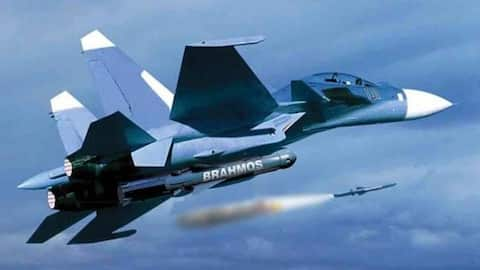#DefenseDiaries: Sukhoi-30MKI armed with BrahMos missile is India's deadliest weapon
What's the story
India has successfully test-fired the BrahMos-A supersonic Air-Launched Cruise Missile (ALCM) from a modified Indian Air Force (IAF) Sukhoi-30MKI fighter jet.
The historic test combines India's deadliest missile with the IAF's most-advanced frontline fighter jet to give birth to one of the world's most lethal military platforms.
In this timeline, we explain the significance of this game-changing alliance.
Details
What we know about the BrahMos ALCM test
The BrahMos-A was "gravity dropped from the Su-30 from fuselage, and the two-stage missile's engine fired up and straightway propelled towards the intended target at the sea in Bay of Bengal," according to the Ministry of Defense (MoD).
It said the missile weights 2.5 tons and is the "heaviest weapon to be deployed on India's Su-30 fighter aircraft."
Twitter Post
Defense minister Nirmala Sitharaman hails BrahMos-A test
India creates a world record and completes Supersonic Cruise Missile Triad by successfully testing #BRAHMOS #ALCM from Indian Air Force Sukhoi-30MKI fighter aircraft. Smt @nsitharaman congratulates Team Brahmos & @DRDO_India for this historic achievement.
— Raksha Mantri (@DefenceMinIndia) November 22, 2017
BrahMos specifications
Nearly impossible to intercept supersonic BrahMos
The Indo-Russian developed BrahMos has a 290-km range and carries a conventional warhead weighing 200 to 300 kgs at a speed of Mach 2.8.
It can also potentially carry nuclear warheads. The BrahMos is also renowned for its pinpoint precision.
The supersonic speeds make it nearly impossible for enemy air-defenses to intercept the missile.
A 450-km range version of the missile is being tested.
Sukhoi specifications
Sukhoi-30MKI has advanced sensors, long range and hauls 3.8-tonnes
The Sukhoi-30MKI is a twin-seater, twin-engine heavy multi-role fighter jet developed by Russia's Irkut Corporation and is licensed manufactured by India's Hindustan Aeronautics Limited (HAL).
It features advanced Indian, Russian and Western avionics and sensors.
It has a maximum speed of Mach 1.9 and unrefuelled flight range of 3,000-km.
It has 12 hardpoints to carry weapons and external fuel tanks weighing up to 3.8-tonnes.
ALCM Development
Both the BrahMos and Sukhoi-30MKI required modification
Over the past few years, HAL and BrahMos Aerospace (the Indo-Russian JV behind the BrahMos) have been working to integrate the missile to the Sukhoi-30MKI.
The Sukhois required structural changes to carry the BrahMos.
The land and sea-launched BrahMos variants weigh 2.9-tonnes. The ALCM is a modified variant and weighs 2.5-tonnes.
Sources said 42 Sukhois would be modified to fire BrahMos ALCM.
Significance
Why is the BrahMos ALCM test is crucial for India?
Following the test, the MoD said the BrahMos is "now capable of being launched from Land, Sea and Air, completing the tactical cruise missile triad for India."
The BrahMos' range is limited to 290-km. Once mated to the Sukhoi-30MKI, its range increases exponentially.
Its supersonic speed makes it nearly impossible for enemy air-defenses to intercept.
All this turns it into a deep surgical-strike missile.
Explained
BrahMos-Sukhoi test would increase missile's export potential
India has offered the BrahMos missile system to Vietnam, which like India is threatened by China's growing military assertiveness.
Meanwhile, seven other countries from the Asia-Pacific, Latin America, and the Middle East have evinced interest in the missile platform.
Several of these countries, including Vietnam, fly variants of the Sukhoi-30 fighter jets.
The BrahMos-A test firing from the Sukhoi-30MKI would increase its export potential.
